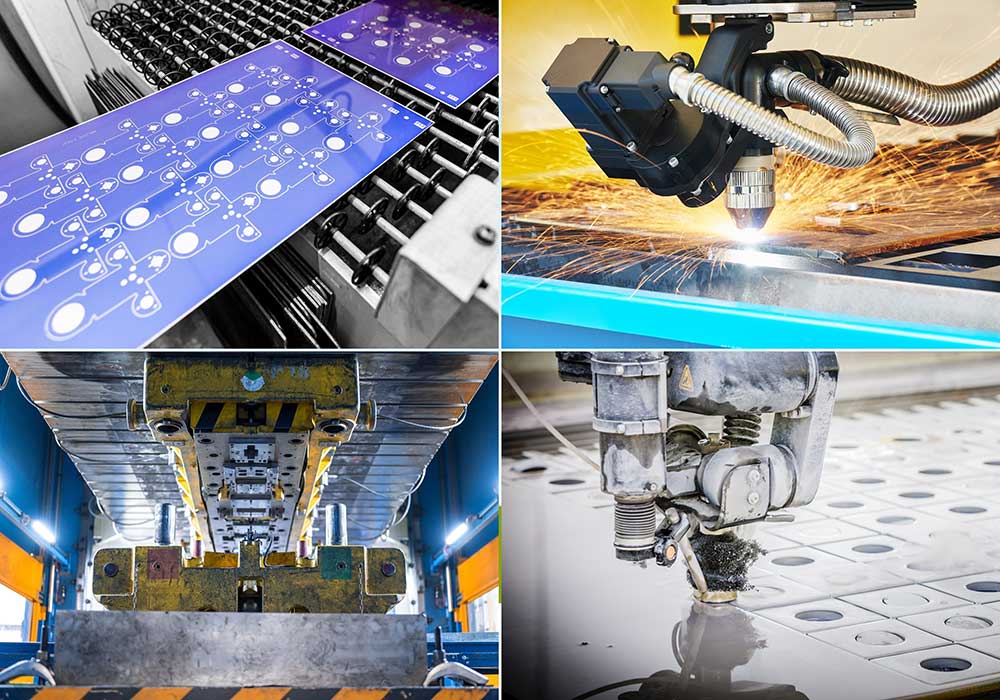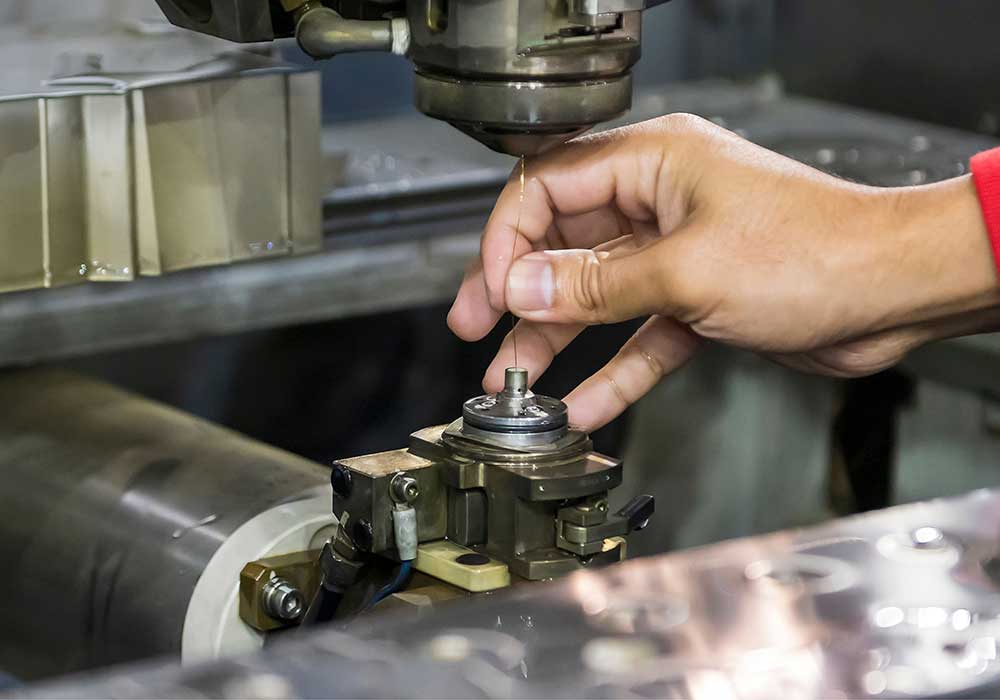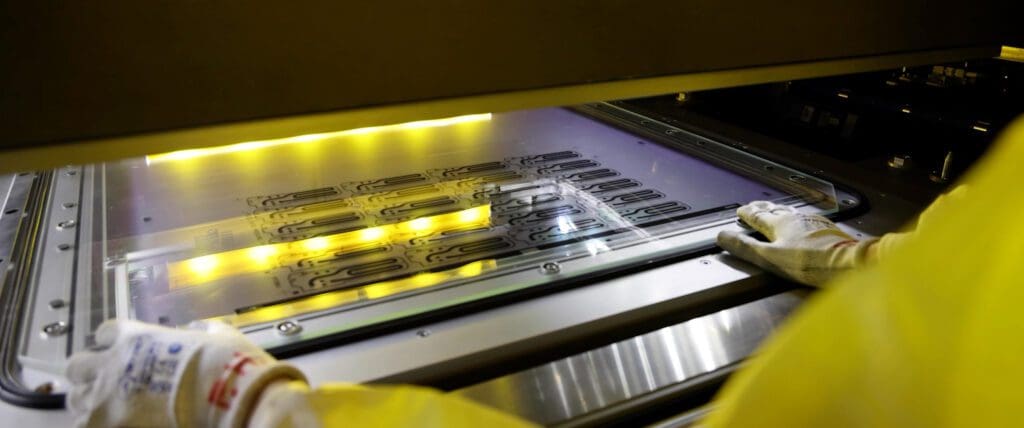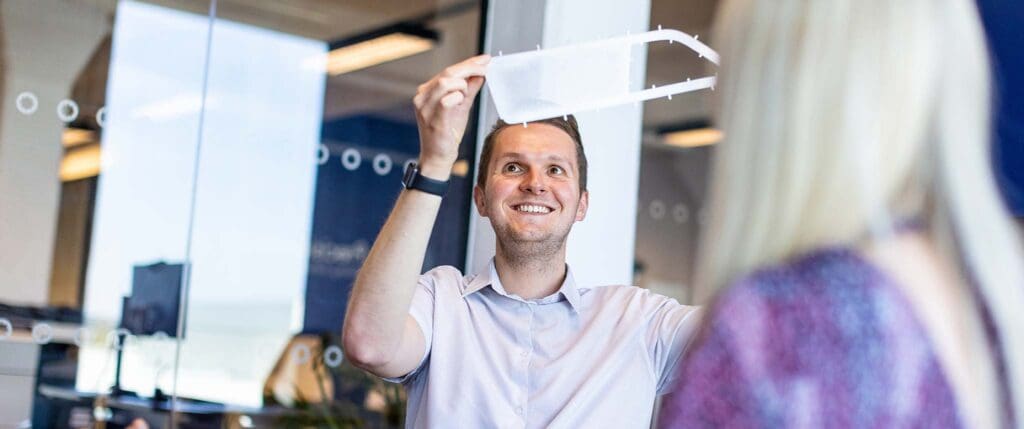Chemical etching vs conventional cutting: How do they stack up?
With a wide variety of sheet metal machining technologies available to design engineers, it can sometimes be difficult to find which cutting method is the best fit for the task at hand.

Part geometry, time, quality of cut and accuracy all factor into the decision of choosing stamping, laser cutting, waterjet cutting, electroforming, wire EDM or chemical etching, the lesser known but often go-to technology for the most complex, safety-critical and exacting precision parts.
To understand how each method stacks up, read below to see our exploration of chemical etching vs conventional cutting methods.

Chemical etching
First, it’s important to understand the process of chemical etching and its benefits.
Chemical etching, also referred to as photochemical machining, chemical milling or photo etching, is a sheet metal machining process which uses chemical etchants to create complex and incredibly accurate precision components out of almost any metal.
The process itself involves ‘printing’ a component design onto a photoresist laminated metal sheet using UV light. Areas of photoresist that haven’t been printed are removed, exposing the metal before it’s completely etched away.

Metal Stamping
Stamping, also known as pressing, is a manufacturing process whereby flat sheet metals are placed into a stamping press and a tool. A die surface forms the metal into the desired shape.
Chemical etching vs metal stamping
As trends have moved towards miniaturisation, micro-stamping has become just as prevalent as chemical etching. However, there is a clear advantage in one process over the other based on cost efficiency, lead times, the complexity of design and quality and accuracy.
Cost efficiency
Stamping requires a significant investment of time and money in tooling and installation. One stamping die can cost thousands, then there’s the extra set-up and maintenance costs that occur over time. Chemical etching features low to no tooling costs.
Lead times
Stamping lead times start between 6-8 weeks just to prepare tooling. Even after the stamping tool is finished, extra time is required to set up the tooling in the stamping press. The lead time of chemical etching can be a matter of hours, meaning you can get your etched parts before a stamping tool is even ready.
Complexity of design
Chemical etching offers greater flexibility, no matter how complex the design is. This is because no tooling investment is required and it has very short lead times. Modifying any design with stamping requires a whole new die and investment in tooling and set up once more. All this means that chemical etching is also perfect for small volumes of prototypes and industrial-sized production.
Quality of cut
The precision micro-manufacturing technology of chemical etching means a higher level of accuracy can be achieved. Etched parts are also burr and stress-free, unlike stamped parts which usually have partial burrs and stress at the cutting edge. Burrs and stresses are likely to affect the performance of your components.

Laser cutting
Laser cutting uses a narrow beam of light to create the desired pattern or shape on a surface. This laser is directed by a controller, which selects the direction, size and intensity of the beam as it cuts into the metal. The types of lasers used for this include gas, diode, and solid-state.
Chemical etching vs laser cutting
While both processes are trusted, there are several differences between chemical etching and laser cutting.
Cost efficiency
Laser cutting can be a good option for small volume production and prototyping. However, for industrial mass production, chemical etching has the edge and is more cost-effective.
Lead times
Chemical etching can make multiple parts simultaneously, but laser cutting cannot do this and can only deal with one component at a time. The etching process produces a large number of products during every run. Laser cutting has a speed advantage when production volume is low, but when it comes to industrial production, chemical etching has shorter lead times.
Complexity of design
Both chemical etching and laser cutting are flexible in design. When the design is incredibly complex, laser cutting takes much longer to complete because it only deals with one part or feature at a time. Chemical etching can work on a whole design at the same time and deliver a huge amount of product in one run.
Quality of cut
The high precision process of chemical etching doesn’t change the properties of metals such as hardness, ductility and grain structure. Additionally, you can create ultra-precision thin metal parts that are burr and stress-free. Conversely, laser cutting is a thermal process, meaning thermal stresses and micro burrs are inevitable.
In summary, chemical etching is a better choice for mid-to-large volume production of precision metal components or complex designs where the quality of cut and accuracy are important.

Waterjet cutting
Waterjet cutting is an industrial manufacturing process that uses a high-pressure jet of water focused into a beam by a nozzle to cut materials. It can be used to cut into metals, glass, granite, wood or rubber.
Chemical etching vs waterjet cutting
Waterjet cutting is often chosen as a cutting method as it offers good tolerances on parts thicker than 12mm. However, if you’re looking to produce thin sheet metal parts at a high volume of production chemical etching is a better option – especially if there’s a demand for high precision.
Cost efficiency
Whereas waterjet cutting involves high operation costs, chemical etching doesn’t require tooling or set-up costs. For a cost-effective solution for both small volume prototypes and large industrial production, chemical etching is the best choice.
Lead times
Similarly to laser cutting, waterjet cutting has to process every feature individually, one after the other. This is a much slower process than etching, which is done simultaneously and at high volume. For more complex prototypes or industrial production, etching has a shorter lead time than water jetting.
Versatility
There is a wide range of metals available for both chemical etching and waterjet cutting.
If you need to make an update to your design, both processes can adjust quickly without extra costs and set up.
Quality of cut
While waterjet cutting can adjust designs quickly, it cannot compare with chemical etching on the quality and accuracy of production. While waterjet machines create no distortion, they may have hazing near the cut. Etching creates no distortion at all and can make excellent sharp edges without burring and stressing.
Electroforming
Electroforming is a metal forming process by electrodeposition. The process is completed in an electrolytic bath and involves two electrodes (an anode and a cathode) and an electrolytic solution. A mandrel is put into the bath and the electrodes pass a DC through the solution. The DC converts metallic ions into atoms that are continuously deposited on the conductive areas of the mandrel until the desired metal thickness has been accomplished.
Chemical etching vs electroforming
While electroforming is an additive manufacturing process, the subtractive chemical etching process shares some similarities as two fast, accurate and cost-effective methods for creating precision metal parts.
Cost efficiency
Both chemical etching and electroforming allow for higher accuracies and tighter tolerances. Depending on the product design and specifications, chemical etching is more cost-effective than electroforming because of the higher volumes the process can manufacture.
Lead times
Both chemical etching and electroforming offer short lead times, with flexible prototype to volume supply.
Complexity of design
Both chemical etching and electroforming can process incredibly complex designs with high accuracy. The limitation of electroforming is down to materials, as mainly nickel and copper can be electroformed. Almost every metal can be chemically etched with no restrictions on the hardness of the materials.
Quality & accuracy
Chemical etching has a high level of accuracy and precision that is possible during manufacturing. While electroforming has a similarly high level of precision and accuracy, the process isn’t suitable for sharp angles and deep or narrow recesses.

Wire EDM
Wire EDM, or electrical discharge machining (EDM), is a machining process that implements electrical sparks to form metal shapes. It’s because of these sparks that you sometimes see EDM referred to as spark machining. In this process, the desired shape is cut from the metal when current discharges occur between two electrodes. During the sparking, cuts are made into the metal to create the intended shape and detach it from the metal sheet.
Wire EDM uses a wire as the tool electrode. The wire is wound up between two spools and during the motion, the active part of the wire constantly switches, stopping the material from eroding from the wire itself.
Chemical etching vs wire EDM
Wire EDM offers precision cut parts with good design freedoms, but there are differences offered by chemical etching that makes it the preferred machining process.
Cost efficiency
To machine through the Wire EDM process, the cost of equipment required to do it is incredibly high. Tooling is also expensive. Both aren’t a problem for chemical etching, making it a more cost-efficient machining process.
Lead times
While modern EDM machines can automate the process to work overnight, it doesn’t fully mitigate the slowness of the process. By comparison, chemical etching can produce batches of components in less than 24 hours.
Versatility
Because of the process involved with wire EDM cutting – the removal of material using rapidly repeating, controlled electrical charges along the metal wire – the method is limited to just electrically conductive metals. Chemical etching has no such restrictions and can be machined with almost any metal.
Quality & accuracy
While EDM machining can produce small parts with conductive metals, the process can cause problems with the final product. With heat involved, thermal expansion, tempering and structural changes can affect the precision quality and accuracy. Burring can also occur during machining.
Chemical etching: the primary cutting method
It’s clear from this exploration of chemical etching and traditional cutting methods that, subject to component geometries, etching can have clear advantages in cost efficiency, fast lead times, suitability with complex designs and can create quality and accurate parts that are burr-free thanks to the elimination of heat or stress.
At Precision Micro, you can expect standard chemical etching lead times of around two to three weeks, but it can be shorter to meet urgent demand thanks to the flexibility of chemical etching. The same cannot be said for the traditional cutting methods which can take much longer to adjust.
Whether you’re looking for microfluidic plates, perforated metal sheets or other key components, Precision Micro has the cost-effective metal processing technology required to get the job done to an exceptional standard.
To discuss your next project, contact us today!
Chemical Etching Whitepaper
Learn how chemical etching can overcome the limitations of traditional sheet metal machining technologies.
Download






